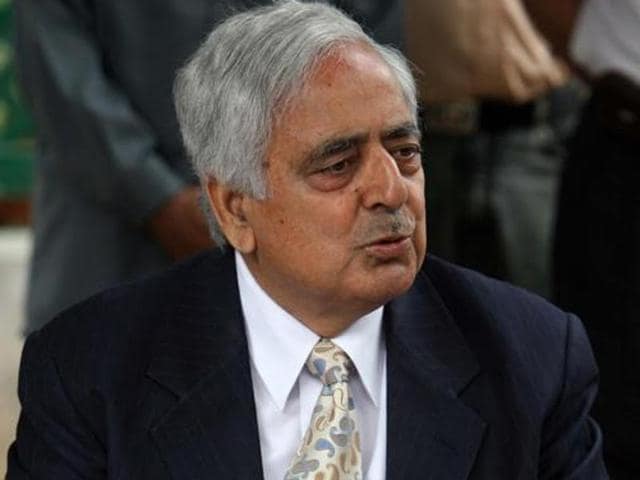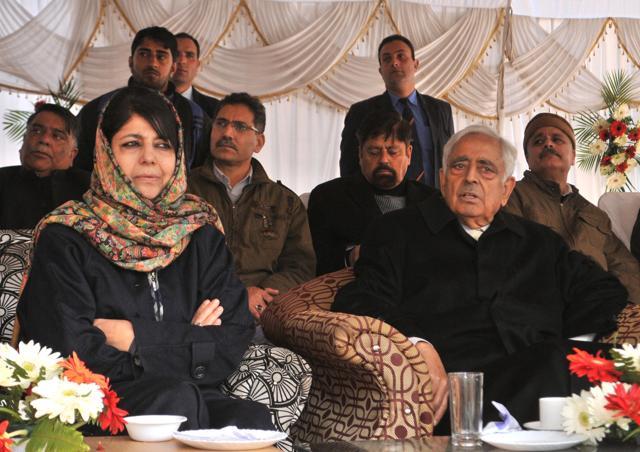Mufti Mohammad Sayeed: Much more than Delhi’s man in Kashmir
In a political career spanning over half a century, Sayeed is credited with turning the state around during his first stint in 2002, becoming the first mainstream politician from Jammu and Kashmir to talk about cordial relations with Pakistan and embarking on a radical, if risky, alliance with the BJP.
Senior politician Mufti Mohammad Sayeed came a long way from being the man with little popular connect and someone who couldn’t win elections outside his south Kashmir stronghold to twice become the chief minister of a state scarred by decades of violence.

In a political career spanning over half a century, Sayeed is credited with turning the state around during his first stint in 2002, becoming the first mainstream politician from Jammu and Kashmir to talk about cordial relations with Pakistan and embarking on a radical, if risky, alliance with the BJP.
Born on January 12, 1936, in Anantnag district’s Bijbehara to a family of clerics, he completed his preliminary studies in Srinagar and earned a law and post-graduate degree in Arabic from Aligarh Muslim University.
His entry into politics happened when he was practicing law in Kashmir and joined a party led by Ghulam Mohammed Sadiq, which was considered a Congress proxy till it merged with the national party years later. He held several important roles in subsequent governments after the National Conference (NC) government was toppled and its charismatic leader Sheikh Abdullah jailed.
Flashback | Mufti Mohammad Sayeed on intolerance, Kashmir and a secular India
In the Congress government led by Mir Qasim in 1972, Sayeed was made a cabinet minister. He was made the state Congress chief after the Indira Gandhi-Sheikh Abdullah accord and his return to power in 1974. After the second NC and Congress alliance during the tenure of Rajiv Gandhi and Farooq Abdullah, Sayeed was sent to the Rajya Sabha and subsequently made the Union tourism minister.
He fell out with the Congress over the Rajiv-Farooq accord in November 1986 and quit the party in 1987 and joined the VP Singh-led formation, becoming the country’s first Muslim home minister in 1989. But within a few days of taking office, the country was thrown into unprecedented turmoil when his daughter Rubaiya Sayeed was kidnapped by militants. The medical student was released after a tense negotiation with the government in exchange of some extremists.
Read More | Mehbooba Mufti set to take over as next CM of Jammu and Kashmir
Sayeed’s tenure as home minister was less than stellar, with the state witnessing a sharp rise in militancy and cases of human rights violation. Many harsh laws that are still widely unpopular in Kashmir were enforced during his tenure.
Sayeed returned to the Congress during the PV Narasimha Rao era but parted ways again in 1999 along with his daughter Mehbooba Mufti to form his own party, the Peoples Democratic Party (PDP). The next few years saw a dramatic turnaround in the fortunes of Sayeed, who had found it difficult to gather candidates for the 1996 elections as Mehbooba rejuvenated the cadre, visiting the families of militants and civilians killed by security forces.
But in the next elections in 2002, his party roundly defeated the NC and formed a government in alliance with the Congress. His first stint as chief minister was nothing short of remarkable for someone once known as Delhi’s man in the Valley.
Read More | Mufti’s demise leaves huge void in politics: PM , Prez condole Sayeed’s death
The state saw the first stirrings of economic development after decades of bruising bloodshed, the removal of encroachments and a much-needed facelift for the capital, Srinagar. Sayeed insisted on zero-tolerance on human rights violations and civilian killings. He played a much bigger role in bringing estranged neighbours India and Pakistan together.
In March 2005, on his watch the first passenger bus crossed the Line of Control through the peace bridge, Aman Sethu, bringing a new thaw in bilateral relations. For the first time, Kashmiris could cross the border without a visa and passport. All they needed was a permit proclaiming that they are residents of Jammu and Kashmir. This paved the way for emotional reunions for hundreds of families to visit their former homes and relatives on the other side — Pakistan-occupied Kashmir.

Although the tenure ended prematurely following differences with the Congress over allocation of land to the Amarnath shrine, Sayeed’s pro-people image loomed large.
He was defeated in the next elections but led the PDP in 2014 to uproot the NC after a disappointing tenure of Omar Abdullah which was marred by street protests and killings. Both the NC and Congress offered him support but Sayeed chose a stable government and did not take the risk of alienating the Union government and the people of Jammu, who overwhelmingly voted for the BJP, to align with the saffron party.
Read More | Key political milestones in Mufti Mohammad Sayeed’s life
But many in his own party feel the BJP’s agenda may wash away his gains in the Valley. As the Narendra Modi government’s initial gestures of generosity waned, Sayeed’s opponents once again started calling him New Delhi’s man in Kashmir. The uneasy silence on the growing religious and regional intolerance left many PDP leaders crying foul.
The work done by this coalition can make or break the 79-year-old’s legacy, with many already saying the BJP alliance has taken Sayeed back to where he began from.
Will Sayeed be remembered as the chief minister who undid his own legacy by ushering in right-wing forces in the Valley or as a leader who dared to break the shackles of convention and allowed himself to align with a party to realise former Prime Minister Atal Bihari Vajpayee’s vision of Kashmiriyat and Insaniyat? Only time will tell.





